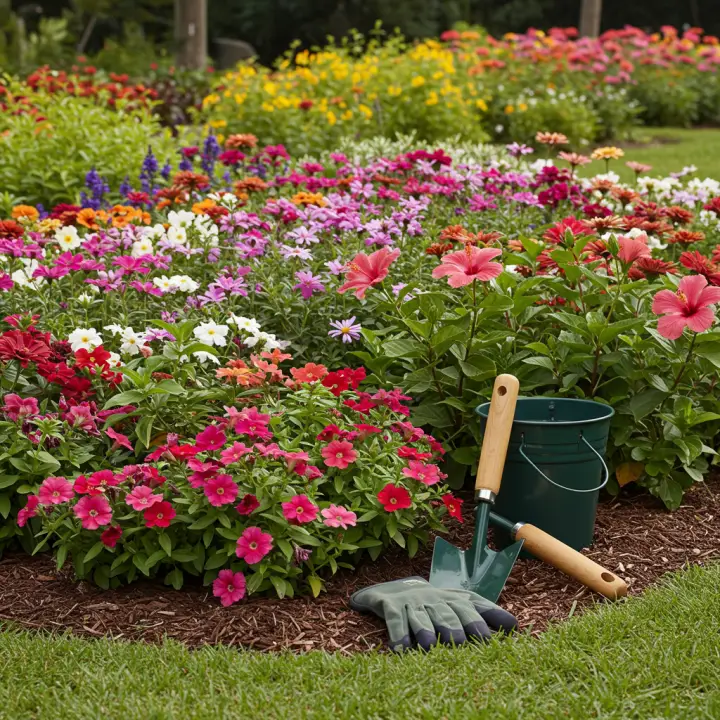Knowing the best time to plant flowers in Florida is crucial for successful gardening. This guide provides a comprehensive overview of planting schedules for different flower types, considering Florida’s unique climate, and offers tips for optimal growth and vibrant blooms throughout the year.

Introduction: Florida’s Floral Landscape
Florida, known as the Sunshine State, boasts a diverse climate ranging from subtropical in the south to more temperate conditions in the north. This unique climate presents both opportunities and challenges for gardeners. Understanding these nuances, particularly concerning temperature fluctuations and rainfall patterns, is key to determining the ideal planting time for different flower varieties. Whether you’re a seasoned gardener or just starting out, this guide will help you navigate Florida’s growing seasons and cultivate a thriving flower garden.
Understanding Florida’s Growing Seasons
Florida essentially has two distinct growing seasons:
Warm Season (Spring/Summer): This period, extending from late February/early March through October, is characterized by high temperatures and humidity. It’s ideal for heat-loving annuals and tropical perennials.
Cool Season (Fall/Winter): Spanning from October/November through February, this season offers milder temperatures and lower humidity, making it suitable for cool-season annuals and some perennials.
Best Time to Plant Specific Flower Types in Florida
Annuals:
Warm-Season Annuals: Plant these sun-loving varieties like zinnias, marigolds, sunflowers, and petunias after the last frost, typically in late February or early March in North Florida and even earlier in South Florida.
Cool-Season Annuals: Pansies, violas, snapdragons, and calendulas thrive in cooler temperatures. Plant them in fall, between October and December, for vibrant winter blooms.
Perennials:
Tropical Perennials: Hibiscus, bougainvillea, and gingers prefer warm weather and should be planted in spring after the last frost.
Other Perennials: Daylilies, coneflowers, and salvia can be planted in spring or fall, depending on the specific variety and your location in Florida.
Bulbs:
Spring-Blooming Bulbs: Tulips, daffodils, and hyacinths require a period of chilling, which can be challenging in Florida. Plant them in pots in late fall and refrigerate for several weeks before planting outdoors in January or February.
Summer-Blooming Bulbs: Caladiums, cannas, and dahlias thrive in the warm summer months. Plant them in spring after the last frost.
Tips for Successful Flower Planting in Florida
Soil Preparation: Florida soils vary greatly, from sandy to clay-rich. Amend your soil with compost or other organic matter to improve drainage and fertility.
Watering: Water deeply and regularly, particularly during dry periods. Avoid overwatering, which can lead to root rot.
Fertilizing: Use a balanced fertilizer formulated for flowering plants. Follow the package instructions carefully.
Mulching: Apply a layer of mulch around your plants to suppress weeds, conserve moisture, and regulate soil temperature.
Pest and Disease Control: Be vigilant about monitoring for pests and diseases. Use appropriate control methods, prioritizing organic options whenever possible.
Sunlight Considerations: Select plants appropriate for the amount of sunlight your garden receives. Some flowers thrive in full sun, while others prefer partial shade.
Microclimates: Recognize that even within Florida, microclimates exist. Consider your specific location’s conditions, including proximity to the coast or large bodies of water, when selecting plants.
Choosing the Right Flowers for Your Florida Garden
Consider these factors when selecting flowers:
Color and Fragrance: Choose flowers based on your desired aesthetic and fragrance preferences.
Size and Shape: Select plants that fit the scale of your garden and complement existing landscaping.
Maintenance Requirements: Opt for low-maintenance varieties if you have limited time for gardening.
Native Plants: Incorporate native Florida flowers to support local ecosystems and attract pollinators.
FAQs: Addressing Common Flower Gardening Questions in Florida
Q: Can I plant flowers year-round in Florida?
A: While Florida’s warm climate allows for extended growing seasons, it’s important to choose plants suited to the specific time of year. Some flowers thrive in the warmer months, while others prefer cooler temperatures.
Q: When is the best time to plant tomatoes in Florida?
A: Although a vegetable, tomatoes are popularly grown in Florida gardens. The best time to plant tomatoes is in late winter/early spring (February-March) for the spring harvest and late summer/early fall (August-September) for the fall harvest.
Q: What are some good low-maintenance flowers for Florida?
A: Consider planting zinnias, sunflowers, lantana, or gaillardia for vibrant color with minimal effort.
Q: How can I protect my flowers from frost damage?
A: Cover vulnerable plants with blankets, sheets, or frost cloth when frost is predicted.
Q: Where can I find more information about Florida-friendly gardening practices?
A: Your local county extension office is a valuable resource for information specific to your region.
Conclusion: Cultivating Your Florida Flower Garden
Gardening in Florida offers unique rewards and challenges. By understanding the state’s diverse climate and following the guidelines presented in this guide, you can select the best time to plant flowers and create a vibrant and flourishing garden that brings beauty and enjoyment throughout the year. Remember to consider your specific location, soil conditions, and desired aesthetic when choosing flower varieties. With careful planning and a little effort, you can enjoy a colorful and fragrant Florida garden year after year.

